
1998 Annual Report --
Contents || Corporate Listings
Value-Focused Global Growth
The Company's renewed commitment to growth in the marketplace is the primary driver for our governing objective of maximizing long-term shareowner value. Our global infrastructure uniquely positions our business for growth. Strong brand equities, innovative ideas, and the accelerated roll-out of convenience foods, supported by increased marketing investment, are critical components of our strategy.
Current global investment opportunities are considerable and require a balancing of future profitable growth with competitive returns in the near term. The application of value-based management principles determines how we allocate scarce resources against competing options. The execution of these strategies will ensure we deliver our commitment of both returning to and sustaining top-line and bottom-line growth in pursuit of value creation.
Management's Discussion and AnalysisKellogg Company and Subsidiaries
Results of operations
Overview
Kellogg Company manufactures and markets ready-to-eat cereal and other grain-based convenience food products, including toaster pastries, frozen waffles, cereal bars, and bagels, throughout the world. Principal markets for these products include the United States and Great Britain. Operations are managed via four major geographic areas - North America, Europe, Asia-Pacific, and Latin America - which are the basis of the Company's reportable operating segment information. The Company leads the global ready-to-eat cereal category with an estimated 38% annualized share
of worldwide volume. Additionally, the Company is the North American market leader in the toaster pastry, cereal/granola bar, frozen waffle, and pre-packaged bagel categories.
During 1998, the Company realized declines in earnings per share both with and without unusual items (discussed below). The Company experienced significant competitive pressure combined with category softness in its major ready-to-eat cereal markets, to which it responded by accelerating investment in long-term growth strategies, including product development, technology, and efficiency initiatives.
For the full year of 1998, Kellogg Company reported net earnings and earnings per share of $502.6 million and $1.23, respectively, compared to 1997 net earnings of $546.0 million and net earnings per share of $1.32. Net earnings and earnings per share for 1996 were $531.0 million and $1.25, respectively. (All per share amounts reflect the 2-for-1 stock split effective August 22, 1997. All earnings per share presented represent both basic and diluted earnings per share.)
During the current and prior years, the Company reported non-recurring charges and other unusual items that have been excluded from all applicable amounts presented below for purposes of comparison between years. Additionally, results for 1997 are presented before the cumulative effect of a change in the method of accounting for business process reengineering costs. Refer to the separate section below on non-recurring charges and other unusual items for further information.
1998 compared to 1997
Excluding non-recurring charges and other unusual items, the Company reported 1998 earnings per share of $1.35, a 21% decrease from the prior-year result of $1.70. The year-to-year decrease in earnings per share of $.35 resulted from $.33 of business decline, $.01 of unfavorable tax rate movements, and $.03 of unfavorable foreign currency movements, partially offset by a $.02 benefit from share repurchase. The business decline was principally attributable to cereal category softness and competitive pressures in North America and Europe, and continued global investments in brand-building marketing activities and streamlining initiatives. Foreign currency movements had a minimal net impact in Europe and negatively impacted earnings by 2% on a consolidated basis due to currency devaluation in Latin America and Asia-Pacific.
The Company realized the following volume results during 1998:
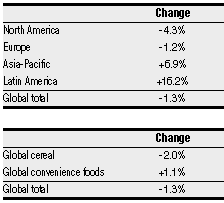
Within North America and Europe, volume declines were principally due to softness in the ready-to-eat cereal business. Asia-Pacific experienced record volume due to a combination of cereal growth and new convenience food product introductions. Latin America continued to post double-digit increases in both ready-to-eat cereal and convenience foods, with record volume results throughout 1998.
The global convenience foods volume increase was driven by double-digit growth in the Company's international markets offset by softness within North America, primarily due to declines in the Lender's Bagels business.
On an annualized basis, regional volume market share of the ready-to-eat cereal category was approximately 33% in North America, 43% in Europe, 43% in Asia-Pacific, and 61% in Latin America.
Consolidated net sales decreased 1% for 1998. Adjusted for unfavorable foreign currency translation, sales were even with the prior year, with the unfavorable impact of volume declines offset by favorable pricing and product mix movements. On an operating segment basis, net sales versus the prior year were:
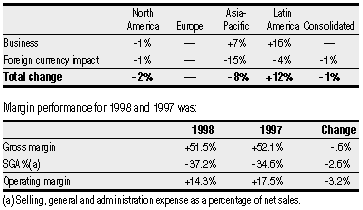
The gross margin decline was due to a combination of the fixed cost absorption impact of lower volumes combined with incremental costs related to launching new products in Europe and North America. The increase in SGA% reflects increased global research and development costs to support our ongoing innovation strategy combined with significant marketing investment and increased spending on streamlining initiatives.
Operating profit (loss) on an operating segment basis was:
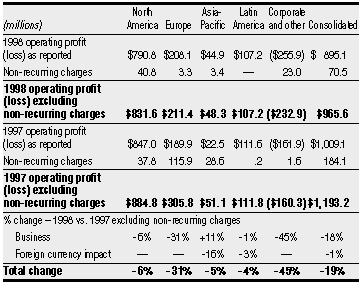
Gross interest expense, prior to amounts capitalized, increased 8% versus the prior year to $127.3 million. The higher interest expense resulted from overall increased debt levels, partially offset by a lower effective interest rate.
Excluding the impact of non-recurring charges and other unusual items, the effective income tax rate was 35.7%, an increase of .4 percentage points versus the prior-year rate. The higher effective tax rate is primarily due to lower earnings and country mix. For both 1998 and 1997, the effective tax rate benefited from statutory rate reductions in the United Kingdom, as well as favorable adjustments in other jurisdictions. The effective income tax rate based on reported earnings (before cumulative effect of accounting change) was 35.8% in 1998 and 37.6% in 1997.
1997 compared to 1996
Excluding non-recurring charges and other unusual items, the Company reported 1997 earnings per share of $1.70, an 11% increase over the prior-year results of $1.53. The year-over-year increase in earnings per share
of $.17 resulted from $.12 of business growth, $.03 of common stock repurchases, and $.04 of favorable tax rate movements, partially offset by $.02 of unfavorable foreign currency movements. The business growth was principally attributable to cereal volume growth in North America and Latin America, continued double-digit growth in convenience foods volume,
and reductions in manufacturing and marketing costs. Foreign currency movements negatively impacted earnings 1% on a consolidated basis. The negative impact of the Lender's Bagels business, acquired in December 1996, was approximately $.05.
The Company achieved the following volume growth during 1997:
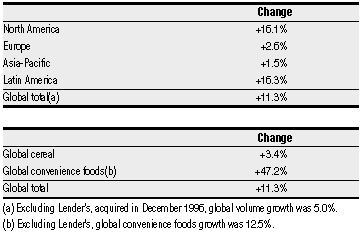
Within North America, the Company recovered cereal volume declines of the prior year, and slightly exceeded 1995 results. Growth in Europe was partially offset by a decline in the United Kingdom, while Asia-Pacific was slowed by softness in Australia. Latin America achieved record annual volume results.
Consolidated net sales increased 2% for 1997. The favorable impact of strong volumes was partially offset by unfavorable pricing and product mix movements, and a negative foreign currency impact of 2%. Excluding the Lender's business, consolidated net sales were even with the prior year. On an operating segment basis, net sales versus the prior year were:
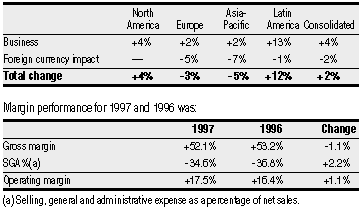
Gross margin performance for 1997 benefited from volume increases and year-over-year operational cost savings. However, these favorable factors were outweighed by the negative impact of prior-year pricing actions. The reduction in SGA% primarily reflects reduced promotional spending in North America.
Operating profit (loss) on an operating segment basis was:
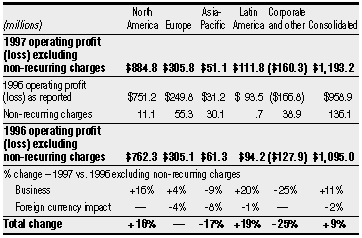
Gross interest expense, prior to amounts capitalized, increased 70% versus the prior year to $117.9 million. The higher interest expense resulted from increased debt levels to fund the Lender's Bagels business acquisition and the Company's common stock repurchase program.
Excluding the impact of non-recurring charges and other unusual items, the effective income tax rate was 35.3%, 1.5 percentage points lower than the prior-year rate. The lower effective tax rate is primarily due to enactment of a 2% statutory rate reduction in the United Kingdom, effective April 1, 1997, as well as favorable adjustments in other jurisdictions. The effective income tax rate based on reported earnings (before cumulative effect of accounting change) was 37.6% in 1997 and 38.2% in 1996. For both 1997 and 1996, the higher reported rate (as compared to the rate excluding the impact of unusual items) primarily relates to certain non-recurring charges for which no tax benefit was provided, based on management's assessment of the likelihood of recovering such benefit in future years.
Other expense for 1996 included a charge of $35.0 million for a contribution to the Kellogg's Corporate Citizenship Fund, a private trust established for charitable donations.
Liquidity and capital resources
The Company's financial condition remained strong throughout 1998. A strong cash flow, combined with a program of issuing commercial paper and maintaining worldwide credit facilities, provides adequate liquidity to meet the Company's operational needs. In August 1998, Moody's lowered its rating on the Company's senior unsecured notes from Aa1 to Aa2 reflecting the Company's increased use of cash for investments in marketing, product development, and other initiatives in the highly competitive markets around the world. Management believes that this change will have an insignificant impact on future borrowing costs. The rating agency confirmed the Company's Prime-1 commercial paper rating.
Net cash provided by operating activities was $719.7 million during 1998, compared to $879.8 million in 1997, with the decrease due principally to lower earnings and unfavorable working capital movements. The ratio of current assets to current liabilities was .9 at December 31, 1998 and 1997.
Net cash used in investing activities was $398.0 million, compared to $329.3 million in 1997. The increase was primarily due to property additions, which increased from $312.4 million in 1997 to $373.9 million for 1998.
Net cash used in financing activities was $358.3 million, primarily related to common stock repurchases of $239.7 million and dividend payments of $375.3 million, partially offset by a net increase in total debt of $241.5 million. The Company's total 1998 per share dividend payment was $.92, a 5.7% increase over the prior-year payment of $.87.
On August 1, 1997, the Company's Board of Directors approved a 2-for-1 stock split to shareholders of record at the close of business August 8, 1997, effective August 22, 1997, and also authorized retirement of 105.3 million common shares (pre-split) held in treasury. All per share and shares outstanding data have been restated retroactively to reflect the stock split.
Under existing plans authorized by the Company's Board of Directors, management spent $239.7 million during 1998 to repurchase 6.3 million shares of the Company's common stock at an average price of $38 per share. The open repurchase authorization, which has been extended through December 31, 1999, was $149.4 million at year-end 1998.
Notes payable primarily consist of commercial paper borrowings in the United States and borrowings under a $200 million revolving credit agreement in Europe with several international banks initiated during December 1998. At December 31, 1998, outstanding borrowings under the revolving credit agreement were $148.5 million with an effective interest rate of 5.5%. U.S. borrowings at December 31, 1998, were $423.3 million with an effective interest rate of 5.2%. Associated with the U.S. borrowings, during September 1997, the Company purchased a $225 million notional, four-year fixed interest rate cap. Under the terms of the cap, if the Federal Reserve AA composite rate on 30-day commercial paper increases to 6.33%, the Company will pay this fixed rate on $225 million of its commercial paper borrowings. If the rate increases to 7.68% or above, the cap will expire. As of year-end 1998, the rate was 4.90%.
In October 1998, the Company issued $200 million of seven-year 4.875% fixed rate U.S. Dollar Notes. Management used the proceeds from this issuance to replace maturing long-term debt. Management entered into a series of interest rate hedges throughout 1998 to effectively fix the interest rate prior to issuance. The effect of the hedges, when combined with original issue discounts, resulted in an overall effective rate for this debt of 6.07%.
To reduce short-term borrowings, on February 4, 1998, the Company issued $400 million of three-year 5.75% fixed rate U.S. Dollar Notes. Accordingly, an equivalent amount of commercial paper borrowings was classified as long-term debt in the December 31, 1997, balance sheet. These Notes were issued under an existing "shelf registration" with the Securities and Exchange Commission, and provide an option to holders to extend the obligation for an additional four years at a predetermined interest rate of 5.63% plus the Company's then-current credit spread. As a result of this option, the effective interest rate on the three-year Notes is 5.23%. Concurrent with this issuance, the Company entered into a $400 million notional, three-year fixed-to-floating interest rate swap, indexed to the Federal Reserve AA composite rate on 30-day commercial paper.
On January 29, 1997, the Company issued $500 million of seven-year 6.625% fixed rate Euro Dollar Notes. This debt was issued primarily to fund the purchase of the Lender's Bagels business, acquired in December 1996. In conjunction with this issuance, the Company settled $500 million notional amount of interest rate forward swap agreements, which effectively fixed the interest rate on the debt at 6.354%. Associated with this debt, during September 1997, the Company entered into a $225 million notional, 41Ú2-year fixed-to-floating interest rate swap, indexed to the three-month London Interbank Offered Rate (LIBOR). Under the terms of this swap, if three-month LIBOR decreases to 4.71% or below, the swap will expire. At year-end 1998, three-month LIBOR was 5.07%.
To replace other long-term debt maturing during 1997, the Company issued $500 million of four-year 6.125% Euro Dollar Notes on August 5, 1997. In conjunction with this issuance, the Company settled $400 million notional amount of interest rate forward swap agreements that effectively fixed the interest rate on the debt at 6.4%. Associated with this debt, during September 1997, the Company entered into a $200 million notional, four-year fixed-to-floating interest rate swap, indexed to three-month LIBOR.
The ratio of total debt to market capitalization at December 31, 1998, was 16%, up from 10% at December 31, 1997, due to a combination of a lower stock price and higher debt levels in 1998.
Non-recurring charges and
other unusual items
From 1995 to the present, management has commenced major productivity and operational streamlining initiatives in an effort to optimize the Company's cost structure. The incremental costs of these programs have been reported throughout 1995-1998 as non-recurring charges.
In addition to the non-recurring charges reported for streamlining initiatives, the Company incurred charges for other unusual items. Furthermore, net earnings for 1997 included a cumulative effect of accounting change related to business process reengineering costs. In summary, the following charges were excluded from reported results for purposes of comparison within the "Results of operations" section above:
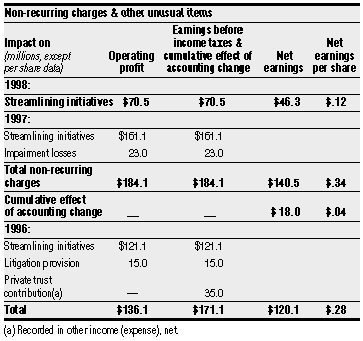
The 1998 streamlining charges relate primarily to an overhead activity analysis that resulted in the elimination of approximately 550 employees and 240 contractors from the Company's headquarters and North American operations through a combination of involuntary early retirement and severance programs. The charges consist mainly of employee retirement and separation benefits, outplacement services, associated consulting and other related costs. This initiative is expected to result in annual pre-tax savings of $105 million, beginning in 1999. Cash outlays for the 1998 charges during 1998 were $8 million, with the remainder to be spent during 1999. Total cash outlays during 1998 for all streamlining initiatives were approximately $47 million. Refer to Note 3 within Notes to Consolidated Financial Statements for further information.
All streamlining programs commenced since 1995, including the aforementioned 1998 initiatives, are expected to result in the elimination of approximately 3,500 employee positions by the end of 1999, with approximately 95% of this reduction already achieved. These programs are expected to deliver average annual pre-tax savings in excess of $300 million by the year 2000, with approximately $250 million of that amount to be realized in 1999. These savings are not necessarily indicative of current and future incremental earnings due to management's commitment to invest in competitive business strategies, new markets, and growth opportunities.
In addition to the non-recurring charges reported during 1997 and 1996 for streamlining initiatives, the Company incurred charges for the following unusual items:
- During 1997, the Company included in non-recurring charges $23.0 million of asset impairment losses which resulted from an evaluation of the Company's ability to recover components of its investments in the emerging markets of Asia-Pacific.
- During 1996, the Company included in non-recurring charges a provision of $15.0 million for the potential settlement of certain litigation.
- During 1996, the Company included in other expense a charge of $35.0 million for a contribution to the Kellogg's Corporate Citizenship Fund, which is expected to satisfy the charitable-giving plans of this private trust through the year 2000.
The Company's streamlining initiatives will continue throughout 1999. The aforementioned overhead activity analysis will be extended to Europe and Latin America during the first half of 1999. Management believes these initiatives will result in the elimination of several hundred employee positions, requiring separation benefit costs to be incurred. Since the number of employees affected, their job functions, and their locations have not yet been identified, the costs that may result are not yet known. The combination of this Europe and Latin America overhead activity analysis and other ongoing cost-reduction programs is expected to result in more than $50 million in incremental savings in 1999.
The foregoing discussion of streamlining initiatives contains forward-looking statements regarding headcount reductions, cash requirements, and realizable savings. Actual amounts may vary depending on the final determination of important factors, such as identification of specific employees to be separated from pre-determined pools, actual amounts of asset removal and relocation costs, dates of asset disposal and costs to maintain assets up to the date of disposal, proceeds from asset disposals, final negotiation of third party contract buy-outs, and other items.
New accounting pronouncements
In March 1998, the Accounting Standards Executive Committee of the American Institute of Certified Public Accountants (AcSEC) issued Statement of Position (SOP) 98-1 "Accounting for the Costs of Computer Software Developed or Obtained for Internal Use." SOP 98-1 provides guidance on the classification of software project costs between expense and capital. During April 1998, AcSEC also issued SOP 98-5 "Reporting on Costs of Start-up Activities." SOP 98-5 prescribes that the costs of opening a new facility, commencing business in a new market, or similar start-up activities must be expensed as incurred. Both of these pronouncements are effective for fiscal years beginning after December 15, 1998. SOP 98-1 is to be applied on a prospective basis to costs incurred on or after the date of adoption. The initial application of SOP 98-5 is
to be reported as a cumulative effect of a change in accounting principle, if material. Management intends to adopt SOP 98-1 and SOP 98-5
effective January 1, 1999, and does not expect the impact of adoption to have a significant impact on the Company's financial results.
In June 1998, the Financial Accounting Standards Board (FASB) issued Statement of Financial Accounting Standards (SFAS) #133 "Accounting for Derivative Instruments and Hedging Activities." This Statement establishes accounting and reporting standards for derivative instruments, requiring recognition of the fair value of all derivatives as assets or liabilities on the balance sheet. SFAS #133 is effective for fiscal years beginning after June 15, 1999. Management intends to adopt the provisions of SFAS #133 effective January 1, 2000, and does not expect the impact of adoption to have a significant impact on the Company's financial results.
On November 20, 1997, the Emerging Issues Task Force (EITF) of the FASB reached a consensus in EITF Issue 97-13 that the costs of business process reengineering activities are to be expensed as incurred. This consensus also applies to business process reengineering activities that are part of an information technology project. Beginning in 1996, the Company has undertaken an Enterprise Business Applications (EBA) initiative that combines design and installation of business processes and software packages to achieve global best practices. Under the EBA initiative, the Company had capitalized certain external costs associated with business process reengineering activities as part of the software asset. EITF Issue 97-13 prescribes that previously capitalized business process reengineering costs should be expensed and reported as a cumulative effect of a change in accounting principle. Accordingly, for the fourth quarter of 1997, the Company reported a charge of $18.0 million (net of tax benefit of $7.7 million) or $.04 per share for write-off of business process reengineering costs. Such costs were expensed as incurred during 1998 and the fourth quarter of 1997 and were insignificant.
Year 2000
The Company established a global program in 1997 to address the
millennium date change issue (the inability of certain computer software, hardware, and other equipment with embedded computer chips to properly process two-digit year-date codes after 1999). The program is structured to address all date-related risks to the Company's business
in four major categories: information technology systems, embedded technology systems, suppliers, and customers.
In the information technology and embedded systems categories, the inventories and detailed assessments are complete, remediation is 70% complete, and testing is 50% complete. Remediation and testing are on schedule with planned completion by June 30, 1999, for business critical and important systems.
The Company is spending approximately $70 million during 1998 and 1999 to become Year 2000 compliant. This amount includes the costs of activities described above, as well as costs to replace non-compliant systems for which replacement was accelerated to meet Year 2000 requirements. On a global basis, spending through December 31, 1998, is consistent with the overall percentage of program completion of approximately 70%. These amounts do not include the effect of other planned system initiatives that will contribute to the Year 2000 compliance effort. Management believes that to the extent these other planned system initiatives impact the Year 2000 project, they will be completed as scheduled by mid-1999.
The Company is continuing a contingency planning process started in 1998 designed to mitigate business risks due to unexpected date-related issues within any of the Year 2000 program categories across all key business units worldwide. The testing results for information technology and embedded systems are being coupled with risk assessments of the Company's suppliers, customers, and other internal initiatives, and incorporated into this contingency planning process. These plans are expected to be defined in each of the Company's four operating segments of North America, Europe, Asia-Pacific, and Latin America by April of 1999, for execution in preparation for the millennium transition.
While management believes that the estimated cost of becoming Year 2000 compliant is not significant to the Company's financial results, failure to complete all the work in a timely manner could result in material financial risk. While management expects all planned work to be completed, there can be no guarantee that all systems will be in compliance by the Year 2000, that the systems of other companies and government agencies on which the Company relies will be converted in a timely manner, or that contingency planning will be able to fully address all potential interruptions. Therefore, date-related issues could cause delays in the Company's ability to produce or ship its products, process transactions, or otherwise conduct business in any of its markets.
Euro conversion
On January 1, 1999, eleven European countries (Germany, France, Spain, Italy, Ireland, Portugal, Finland, Luxembourg, Belgium, Austria, and
the Netherlands) implemented a single currency zone, the Economic and Monetary Union (EMU). The new currency, the Euro, has become the
official currency of the participating countries. Those countries' financial markets and banking systems are quoting financial and treasury data in Euros from January 1, 1999.
The Euro will exist alongside the old national currencies during a transition period from January 1, 1999, to January 1, 2002. During this period, entities within participating countries must complete changes which enable them to transact in the Euro. National currencies will be withdrawn no later than July 1, 2002. This transition to the Euro currency will involve changing budgetary, accounting, pricing, costing, and fiscal systems in companies and public administrations, as well as the simultaneous handling of parallel currencies and conversion of legacy data. During the first quarter of 1999, the Euro currency has demonstrated stability. However, this early stability needs to be observed over a longer period before conclusions can be drawn on the currency's long-term viability.
In early 1998, management formed a task force to monitor EMU developments, evaluate the impact of the Euro conversion on the Company's operations, and develop and execute action plans, as necessary. The task force has completed a full EMU impact assessment identifying company-wide, cross-functional effects of the Euro. Required business strategy, system, and process changes within the Company's European region are under way with certain markets already Euro compliant. Many of these changes will be made in conjunction with other significant technology initiatives currently under way, and will be completed in accordance with the Company's timetable for transacting with its suppliers and customers in the Euro. Results of task force assessments indicate that most suppliers and customers desire to initiate Euro transactions during 2000 and 2001.
Management expects to complete financial, operational, and manufacturing system conversions during 2001. Although Management currently believes the Company will be able to accommodate any required changes in its operations, there can be no assurance that the Company, its customers, suppliers, financial service providers, or government agencies will meet all of the Euro currency requirements on a timely basis. Such failure to complete the necessary work could result in material financial risk.
1999 outlook
Management is not aware of any adverse trends that would materially affect the Company's strong financial position. Should suitable investment opportunities or working capital needs arise that would require additional financing, management believes that the Company's strong credit rating, balance sheet, and earnings history provide a base for obtaining additional financial resources at competitive rates and terms. Based on the expectation of cereal volume growth, and strong results from product innovation and the continued global roll-out of convenience foods, management believes the Company is well-positioned to deliver sales and earnings growth for the full year 1999. The Company will continue to identify and pursue streamlining and productivity initiatives to optimize its cost structure.
The Company is currently reviewing strategies related to the Lender's Bagels business, given its performance since acquisition. The Company has evaluated the recoverability of Lender's long-lived assets as of December 31, 1998, and although this evaluation has not resulted in the recognition of an impairment loss, management expects to update its assessment during 1999.
Additional expectations for 1999 include a gross profit margin of 51-52%, an SGA% of 36-37%, an effective income tax rate of 36-37%, and capital spending of approximately $270 million.
The foregoing projections concerning impact of future borrowing costs, accounting changes, volume growth, profitability, capital spending, and common stock repurchase activity are forward-looking statements that involve risks and uncertainties. Actual results may differ materially due to the impact of competitive conditions, marketing spending and/or incremental pricing actions on actual volumes and product mix; the levels of spending on system initiatives, properties, business opportunities, continued streamlining initiatives, and other general and administrative costs; raw material price and labor cost fluctuations; foreign currency exchange rate fluctuations; changes in statutory tax law; interest rates available on short-term financing; the impact of stock market conditions on common stock repurchase activity; and other items.